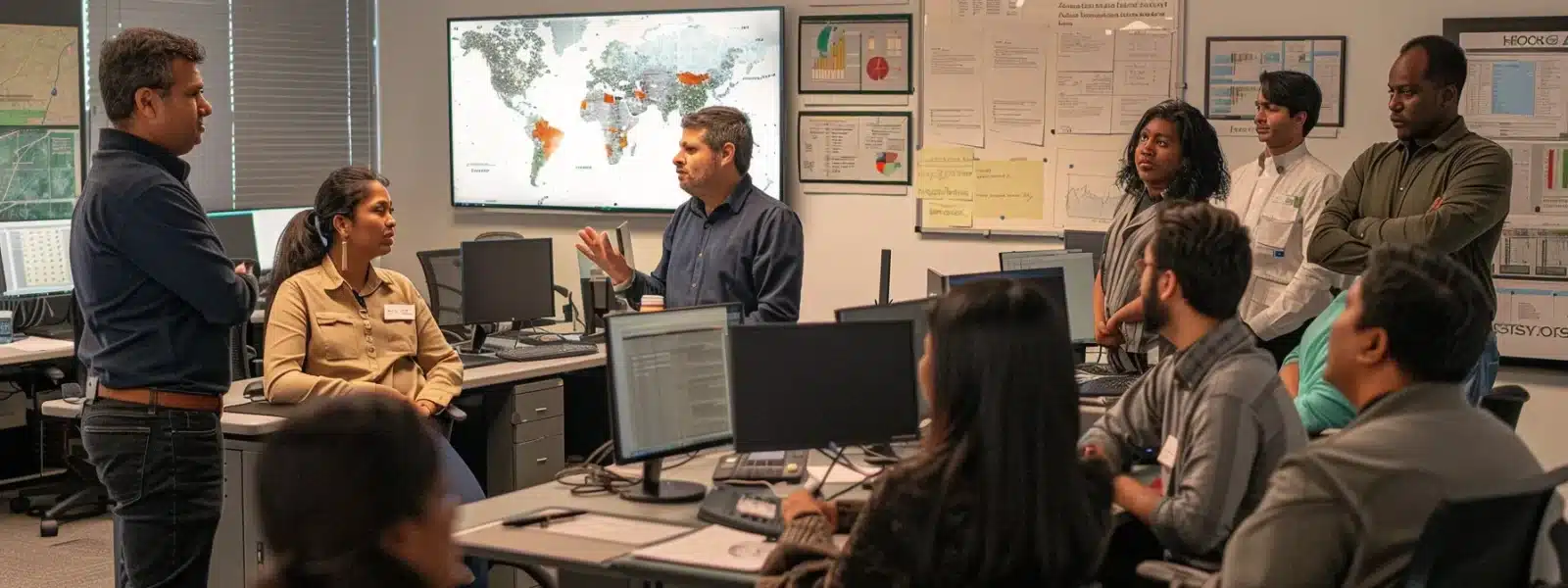Achieving CMMC certification is essential for businesses handling sensitive data, yet many struggle with the complexities involved. A pre-assessment gap analysis can significantly enhance readiness by identifying weaknesses in governance, policy, and compliance with federal acquisition regulations. This article will explore the benefits of conducting a thorough gap analysis, outline key steps for effective implementation, and discuss common gaps found during assessments. By addressing these issues, businesses can streamline their CMMC consulting efforts and mitigate risks, ultimately paving the way for successful certification.
Key Takeaways
- Conducting a pre-assessment gap analysis identifies vulnerabilities before the CMMC certification audit
- Early identification of compliance gaps streamlines the path to achieving CMMC certification
- Engaging certified assessors enhances readiness and ensures alignment with CMMC requirements
- Regular training fosters a culture of security awareness among employees, supporting compliance efforts
- Organizing compliance documentation simplifies the review process during the certification audit
Understanding the Role of Pre-Assessment Gap Analysis in CMMC Certification

Understanding the role of pre-assessment gap analysis in CMMC certification is essential for organizations aiming to enhance their compliance efforts. This process identifies vulnerabilities within the supply chain and prepares businesses for CMMC assessments. By linking pre-assessment activities to certification success, organizations can effectively address potential phishing threats and ensure a robust security posture with the help of cmmc consulting.
Exploring the Objectives of CMMC Certification
The primary objective of CMMC certification is to ensure that organizations handling Controlled Unclassified Information (CUI) implement robust information security practices. This certification framework establishes a set of standards that organizations must meet to protect sensitive data from unauthorized access and cyber threats. By achieving CMMC certification, businesses demonstrate their commitment to safeguarding CUI, which is crucial for maintaining trust with clients and partners.
Another key objective of CMMC certification is to enhance the overall security posture of an organization. This involves conducting thorough penetration tests and implementing effective firewalls to identify and mitigate vulnerabilities. By addressing these security gaps, organizations can better protect their systems and data, ultimately reducing the risk of data breaches and cyberattacks.
Furthermore, CMMC certification aims to create a standardized approach to cybersecurity across the defense supply chain. This standardization helps ensure that all users within the supply chain adhere to the same security protocols, fostering a collaborative environment for information sharing and protection. As organizations work towards certification, they not only improve their own security measures but also contribute to a more secure ecosystem for all stakeholders involved.
How Gap Analysis Enhances Compliance Efforts
Gap analysis plays a crucial role in enhancing compliance efforts by identifying areas where an organization may fall short of CMMC requirements. By conducting interviews with key personnel, organizations can gather evidence of current practices and pinpoint any conflict of interest that may hinder compliance. This strategic approach allows businesses to develop targeted plans to address deficiencies, ensuring they are well-prepared for the certification process.
Furthermore, a thorough gap analysis provides organizations with a clear strategy for achieving regulatory compliance. It enables them to assess their existing security measures against the CMMC framework, highlighting specific areas that require improvement. By understanding these gaps, organizations can prioritize their resources effectively, focusing on the most critical aspects of their cybersecurity posture to enhance overall readiness for certification.
Additionally, the insights gained from a gap analysis can inform ongoing compliance efforts beyond the initial certification. Organizations can use the findings to establish a continuous improvement process, regularly reviewing and updating their security practices. This proactive stance not only helps maintain compliance but also strengthens the organization’s resilience against evolving cyber threats, ultimately fostering a culture of security awareness and accountability.
Linking Pre-Assessment to Certification Success
Linking pre-assessment activities to CMMC certification success is vital for organizations aiming to enhance their risk management strategies. A thorough gap assessment allows businesses to identify weaknesses in their infrastructure before undergoing the formal CMMC assessment. By addressing these vulnerabilities early, organizations can significantly improve their chances of achieving certification and maintaining compliance.
Engaging with an expert during the pre-assessment phase can provide invaluable insights into the specific requirements of the CMMC framework. These professionals can guide organizations in conducting a comprehensive gap assessment, ensuring that all critical areas are evaluated. This proactive approach not only prepares businesses for the certification process but also fosters a culture of security awareness that is essential for long-term compliance.
Furthermore, the insights gained from a pre-assessment gap analysis can inform ongoing risk management efforts. Organizations can develop targeted action plans based on the findings, allowing them to prioritize improvements in their cybersecurity posture. This continuous improvement process not only enhances readiness for the CMMC assessment but also strengthens the overall security framework, making it more resilient against evolving cyber threats.
Benefits of a Thorough CMMC Pre-Assessment Gap Analysis

A thorough CMMC pre-assessment gap analysis enables organizations to identify compliance shortcomings early, optimizing resource allocation for remediation. This proactive methodology minimizes the risks of certification delays while strengthening the overall security posture. By engaging leadership, including the chief information officer, in this process, organizations can ensure a comprehensive approach to achieving CMMC certification readiness.
Identifying Compliance Shortcomings Early
Identifying compliance shortcomings early is a critical advantage of conducting a thorough CMMC pre-assessment gap analysis. By pinpointing areas of risk related to access control and other security measures, organizations can take proactive steps to address these vulnerabilities before the formal certification process. This early detection not only streamlines the path to CMMC certification but also enhances the overall security posture of the organization.
Organizations that engage in a pre-assessment gap analysis can effectively evaluate their current practices against the CMMC certification requirements. This evaluation helps in recognizing specific deficiencies, such as inadequate access control measures or insufficient risk management strategies. By addressing these shortcomings early, businesses can allocate resources more efficiently, ensuring that critical areas are prioritized for remediation.
Furthermore, early identification of compliance gaps allows organizations to develop targeted action plans that align with CMMC certification goals. For instance, if a gap analysis reveals weaknesses in risk management practices, organizations can implement necessary changes to strengthen their compliance framework. This proactive approach not only prepares them for certification but also fosters a culture of continuous improvement, ultimately leading to a more resilient security environment.
Optimizing Resource Allocation for Remediation
Optimizing resource allocation for remediation is a critical aspect of preparing for Cybersecurity Maturity Model Certification (CMMC). By conducting a thorough pre-assessment gap analysis, organizations can identify specific threats and vulnerabilities that require immediate attention. This targeted approach allows businesses to allocate their resources effectively, ensuring that the most pressing issues are addressed first, which is essential for achieving compliance with the National Institute of Standards and Technology (NIST) guidelines.
Furthermore, organizations can leverage analytics from the gap analysis to prioritize remediation efforts based on risk levels. For instance, if the analysis reveals weaknesses in incident response capabilities, resources can be directed toward enhancing those areas. This strategic allocation not only streamlines the remediation process but also strengthens the overall cybersecurity posture, making it easier for organizations to meet CMMC requirements.
In addition, optimizing resource allocation fosters a culture of proactive security management. By addressing identified gaps early, organizations can implement necessary changes without the pressure of impending assessments. This forward-thinking mindset not only prepares businesses for CMMC certification but also enhances their resilience against evolving cyber threats, ultimately contributing to a more secure operational environment.
Minimizing Risks of Certification Delays
Minimizing risks of certification delays is a critical benefit of conducting a thorough CMMC pre-assessment gap analysis. By performing an early evaluation of existing security measures, organizations can identify potential vulnerabilities that may hinder their accreditation process. This proactive approach allows businesses to address issues before they escalate, ensuring a smoother path to achieving compliance with CMMC requirements.
Organizations that engage in a comprehensive vulnerability assessment can pinpoint specific areas that require immediate attention, such as gaps in access control or inadequate incident response protocols. By prioritizing these issues, they can allocate resources effectively, reducing the likelihood of delays during the formal audit process. This strategic focus not only enhances readiness for certification but also strengthens the overall security framework.
Furthermore, addressing compliance gaps early in the process helps organizations maintain their contracts with clients and partners. By demonstrating a commitment to cybersecurity and compliance, businesses can build trust and confidence among stakeholders. This not only minimizes the risk of certification delays but also positions the organization as a reliable partner in the defense supply chain.
| Benefit | Description |
|---|---|
| Early Identification | Pinpoints vulnerabilities before the formal audit, allowing for timely remediation. |
| Resource Allocation | Enables effective prioritization of critical issues, streamlining the certification process. |
| Stakeholder Trust | Builds confidence among clients and partners, ensuring contract compliance. |
Strengthening Overall Security Posture
Strengthening the overall security posture is a significant benefit of conducting a thorough CMMC pre-assessment gap analysis. By identifying vulnerabilities early, organizations can implement necessary security measures that align with CMMC requirements. This proactive approach not only enhances compliance but also fortifies defenses against potential cyber threats.
Organizations that engage in a pre-assessment gap analysis can develop a comprehensive understanding of their security landscape. For instance, by evaluating existing access controls and incident response protocols, they can pinpoint weaknesses that need immediate attention. Addressing these gaps ensures that the organization is better equipped to handle security incidents, thereby reducing the risk of data breaches.
Moreover, a robust security posture fosters a culture of accountability and awareness among employees. When organizations prioritize security improvements based on gap analysis findings, they create an environment where all staff members understand their role in maintaining cybersecurity. This collective effort not only prepares the organization for CMMC certification but also contributes to long-term resilience against evolving cyber threats:
- Identifying vulnerabilities early enhances compliance.
- Evaluating access controls strengthens defenses against threats.
- Fostering a culture of accountability improves overall security awareness.
Key Steps to Conduct an Effective Pre-Assessment Gap Analysis

To conduct an effective pre-assessment gap analysis for CMMC certification, organizations should focus on several key steps. First, assembling an experienced assessment team is crucial for gathering insights. Next, reviewing current cybersecurity practices allows for a clear understanding of existing measures. Comparing these practices against CMMC requirements helps identify compliance gaps, which should then be documented and prioritized for action. This structured approach enhances readiness for certification.
Assembling an Experienced Assessment Team
Assembling an experienced assessment team is a critical step in conducting an effective pre-assessment gap analysis for CMMC certification. This team should include individuals with diverse expertise in cybersecurity, compliance, and risk management. By bringing together professionals who understand the nuances of the CMMC framework, organizations can ensure a comprehensive evaluation of their current practices and identify areas needing improvement.
It is essential for the assessment team to have a clear understanding of the specific requirements outlined in the CMMC model. Team members should be well-versed in the various levels of certification and the associated practices and processes. This knowledge enables them to accurately assess the organization‘s existing security measures against the CMMC standards, ensuring that all compliance gaps are identified and addressed effectively.
Furthermore, engaging team members from different departments, such as IT, legal, and operations, can provide a holistic view of the organization‘s security posture. This collaborative approach fosters communication and ensures that all relevant perspectives are considered during the gap analysis. By leveraging the collective expertise of the assessment team, organizations can maximize their readiness for CMMC certification and enhance their overall cybersecurity framework:
| Team Member Role | Expertise Required |
|---|---|
| Cybersecurity Specialist | Knowledge of security protocols and threat mitigation strategies. |
| Compliance Officer | Understanding of CMMC requirements and regulatory standards. |
| IT Manager | Experience in managing IT infrastructure and security measures. |
| Legal Advisor | Insight into legal implications and data protection regulations. |
Reviewing Current Cybersecurity Practices
Reviewing current cybersecurity practices is a fundamental step in conducting a pre-assessment gap analysis for CMMC certification. Organizations must evaluate their existing security measures, including access controls, incident response protocols, and data protection strategies. This review helps identify any deficiencies that could hinder compliance with CMMC requirements, allowing businesses to take proactive steps to address these gaps.
During this review, organizations should document their current practices and compare them against the CMMC framework. This comparison highlights specific areas where improvements are necessary, such as enhancing user authentication methods or updating security policies. By understanding these discrepancies, organizations can prioritize their remediation efforts effectively, ensuring they focus on the most critical aspects of their cybersecurity posture.
Furthermore, engaging team members from various departments during the review process fosters a comprehensive understanding of the organization‘s security landscape. This collaborative approach ensures that all relevant perspectives are considered, leading to a more thorough evaluation. By leveraging insights from different areas, organizations can develop a robust action plan that aligns with CMMC certification goals:
| Current Practice | Potential Gap | Recommended Action |
|---|---|---|
| Access Control | Inadequate user authentication | Implement multi-factor authentication |
| Incident Response | Outdated response protocols | Update and test incident response plan |
| Data Protection | Insufficient encryption measures | Enhance encryption for sensitive data |
Comparing Practices Against CMMC Requirements
Comparing current practices against CMMC requirements is a vital step in the pre-assessment gap analysis process. Organizations must systematically evaluate their existing cybersecurity measures, such as access controls and incident response protocols, to identify discrepancies with the CMMC framework. This comparison not only highlights areas needing improvement but also provides a clear roadmap for achieving compliance.
During this evaluation, organizations should document their findings and prioritize the gaps based on their potential impact on security. For instance, if an organization discovers that its user authentication methods do not meet CMMC standards, it can take immediate action to implement multi-factor authentication. This proactive approach ensures that critical vulnerabilities are addressed before the formal certification process begins.
Furthermore, engaging various departments in this comparison fosters a comprehensive understanding of the organization‘s security posture. By incorporating insights from IT, compliance, and risk management teams, organizations can develop a more robust action plan that aligns with CMMC certification goals. This collaborative effort not only enhances readiness for certification but also strengthens the overall cybersecurity framework, making it more resilient against potential threats.
Documenting Gaps and Prioritizing Actions
Documenting gaps is a critical step in the pre-assessment gap analysis process for CMMC certification. Organizations should meticulously record identified deficiencies in their cybersecurity practices, such as weaknesses in access controls or outdated incident response protocols. This documentation serves as a foundation for developing targeted action plans that address these vulnerabilities effectively.
Once gaps are documented, prioritizing actions becomes essential for efficient remediation. Organizations should assess the potential impact of each gap on their overall security posture and compliance with CMMC requirements. By focusing on the most critical issues first, businesses can allocate resources effectively, ensuring that they address vulnerabilities that pose the greatest risk to their operations.
Additionally, prioritizing actions based on documented gaps fosters a proactive approach to cybersecurity. Organizations can implement changes systematically, tracking progress and adjusting strategies as needed. This ongoing process not only enhances readiness for CMMC certification but also strengthens the organization’s overall security framework, making it more resilient against evolving cyber threats.
Common Gaps Found During CMMC Pre-Assessments

Common gaps identified during CMMC pre-assessments often include inadequate access controls and authentication measures, insufficient incident response planning, lapses in security awareness training, and weaknesses in data protection measures. Addressing these vulnerabilities is crucial for organizations seeking to enhance their cybersecurity posture and achieve compliance. Each of these areas will be explored in detail to provide practical insights for maximizing readiness for CMMC certification.
Inadequate Access Controls and Authentication
Inadequate access controls and authentication measures represent a significant gap for organizations preparing for CMMC certification. Many businesses fail to implement robust user authentication protocols, which can lead to unauthorized access to sensitive data. This vulnerability not only jeopardizes compliance but also increases the risk of data breaches, making it essential for organizations to prioritize strengthening their access control systems.
Organizations should evaluate their current access control practices to identify weaknesses, such as the absence of multi-factor authentication or outdated password policies. By addressing these deficiencies, businesses can enhance their security posture and align with CMMC requirements. Implementing strong authentication measures not only protects Controlled Unclassified Information (CUI) but also fosters a culture of security awareness among employees.
Furthermore, regular training on access control policies is crucial for maintaining compliance and minimizing risks. Employees must understand the importance of safeguarding sensitive information and adhering to established protocols. By investing in training and awareness programs, organizations can ensure that their workforce is equipped to recognize and respond to potential security threats, ultimately supporting their journey toward CMMC certification.
Insufficient Incident Response Planning
Insufficient incident response planning is a critical gap that organizations often encounter during CMMC pre-assessments. Many businesses lack a well-defined incident response plan, which can lead to confusion and delays in addressing security incidents. This deficiency not only jeopardizes compliance with CMMC requirements but also increases the risk of data breaches and operational disruptions.
Organizations should prioritize developing a comprehensive incident response plan that outlines clear procedures for identifying, responding to, and recovering from security incidents. This plan should include roles and responsibilities, communication protocols, and steps for post-incident analysis. By implementing a structured approach, businesses can enhance their readiness for CMMC certification and ensure a swift response to potential threats.
Regular training and simulations are essential for maintaining an effective incident response plan. Employees must be familiar with their roles in the event of a security incident to minimize response times and mitigate damage. By investing in ongoing training and awareness programs, organizations can foster a culture of preparedness, ultimately supporting their journey toward achieving CMMC certification.
Lapses in Security Awareness Training
Lapses in security awareness training represent a significant gap for organizations pursuing CMMC certification. Many employees may not fully understand the importance of cybersecurity protocols, leading to unintentional breaches or mishandling of sensitive information. This lack of awareness can hinder compliance efforts and increase vulnerability to cyber threats, making it essential for organizations to prioritize comprehensive training programs.
To address this gap, organizations should implement regular security awareness training sessions that cover key topics such as phishing threats, password management, and data protection practices. By equipping employees with the knowledge to recognize and respond to potential security risks, businesses can foster a culture of security that supports their CMMC certification goals. Engaging training methods, such as simulations and real-world scenarios, can enhance retention and application of security practices.
Furthermore, ongoing evaluation of training effectiveness is crucial for maintaining a strong security posture. Organizations should assess employee understanding through quizzes or practical exercises, allowing them to identify areas needing improvement. By continuously refining their security awareness training, businesses can ensure that their workforce remains vigilant and informed, ultimately contributing to a more secure environment as they work towards CMMC certification:
| Training Focus | Importance | Action Steps |
|---|---|---|
| Phishing Awareness | Recognizing and avoiding phishing attempts | Conduct regular simulations and training sessions |
| Password Management | Understanding strong password practices | Implement policies for password complexity and rotation |
| Data Protection | Safeguarding sensitive information | Provide guidelines for data handling and storage |
Weaknesses in Data Protection Measures
Weaknesses in data protection measures are a common gap identified during CMMC pre-assessments. Organizations often lack adequate encryption protocols for sensitive data, which can expose Controlled Unclassified Information (CUI) to unauthorized access. Implementing strong encryption practices is essential for safeguarding data both at rest and in transit, ensuring compliance with CMMC requirements.
Another frequent issue is the absence of comprehensive data handling policies. Many organizations do not have clear guidelines on how to classify, store, and dispose of sensitive information. Establishing robust data protection policies helps organizations mitigate risks associated with data breaches and enhances their overall security posture, which is critical for achieving CMMC certification.
Furthermore, regular audits and assessments of data protection measures are often overlooked. Organizations should conduct periodic reviews to identify vulnerabilities and ensure that their data protection strategies remain effective against evolving cyber threats. By prioritizing these assessments, businesses can strengthen their defenses and improve their readiness for CMMC certification:
- Implement strong encryption protocols for sensitive data.
- Establish clear data handling policies to mitigate risks.
- Conduct regular audits to identify vulnerabilities in data protection measures.
Strategies to Address and Close Identified Gaps

To effectively address and close identified gaps in preparation for CMMC certification, organizations should focus on implementing technical solutions for security, updating policies and procedures, enhancing employee training programs, and regularly monitoring and reviewing compliance. Each of these strategies plays a crucial role in strengthening the overall security posture and ensuring alignment with CMMC requirements.
By adopting these practical insights, businesses can create a robust framework that not only meets compliance standards but also fosters a culture of continuous improvement in cybersecurity practices.
Implementing Technical Solutions for Security
Implementing technical solutions for security is a critical step in addressing gaps identified during the pre-assessment gap analysis for CMMC certification. Organizations should prioritize the deployment of advanced security technologies, such as firewalls, intrusion detection systems, and endpoint protection solutions. These tools not only help to safeguard sensitive data but also align with CMMC requirements, ensuring that businesses are better prepared for the certification process.
Moreover, organizations can enhance their security posture by adopting encryption protocols for data at rest and in transit. This practice protects Controlled Unclassified Information (CUI) from unauthorized access and potential breaches. By integrating strong encryption measures, businesses demonstrate their commitment to data protection, which is essential for achieving compliance with CMMC standards.
Regular updates and patches to software and systems are also vital in maintaining a secure environment. Organizations should establish a routine for monitoring vulnerabilities and applying necessary updates to their security infrastructure. This proactive approach not only mitigates risks but also reinforces the organization’s overall readiness for CMMC certification, ultimately fostering a culture of continuous improvement in cybersecurity practices.
Updating Policies and Procedures
Updating policies and procedures is a fundamental strategy for organizations preparing for CMMC certification. By reviewing and revising existing security policies, businesses can ensure alignment with the latest CMMC requirements. This process not only addresses identified gaps but also establishes a clear framework for maintaining compliance and enhancing overall security posture.
Organizations should focus on creating comprehensive documentation that outlines security protocols, incident response plans, and data protection measures. For example, updating access control policies to include multi-factor authentication can significantly reduce the risk of unauthorized access. By implementing these changes, organizations demonstrate their commitment to safeguarding Controlled Unclassified Information (CUI) and achieving CMMC certification.
Regularly revising policies and procedures fosters a culture of continuous improvement within the organization. This proactive approach encourages employees to stay informed about security practices and their roles in maintaining compliance. By engaging staff in the policy update process, organizations can enhance awareness and accountability, ultimately supporting their journey toward CMMC certification:
| Policy Area | Action Steps | Expected Outcome |
|---|---|---|
| Access Control | Implement multi-factor authentication | Reduce unauthorized access risks |
| Incident Response | Develop and document response protocols | Enhance readiness for security incidents |
| Data Protection | Establish clear data handling policies | Safeguard sensitive information |
Enhancing Employee Training Programs
Enhancing employee training programs is a vital strategy for organizations preparing for CMMC certification. By providing comprehensive training on cybersecurity protocols, businesses can ensure that employees understand their roles in protecting Controlled Unclassified Information (CUI). Regular training sessions that cover topics such as phishing awareness and data protection practices can significantly reduce the risk of human error, which is often a leading cause of security breaches.
Organizations should implement engaging training methods, such as interactive workshops and real-world simulations, to reinforce learning and retention. For instance, conducting phishing simulations can help employees recognize and respond to potential threats effectively. By fostering a culture of security awareness, organizations not only enhance their compliance efforts but also empower their workforce to actively contribute to the organization‘s cybersecurity posture.
Furthermore, ongoing evaluation of training effectiveness is essential for maintaining a strong security framework. Organizations can assess employee understanding through quizzes and practical exercises, allowing them to identify areas needing improvement. By continuously refining their training programs, businesses can ensure that their workforce remains vigilant and informed, ultimately supporting their journey toward CMMC certification:
- Implement comprehensive training on cybersecurity protocols.
- Utilize engaging methods like workshops and simulations.
- Regularly evaluate training effectiveness to identify improvement areas.
Regularly Monitoring and Reviewing Compliance
Regularly monitoring and reviewing compliance is essential for organizations striving for CMMC certification. This ongoing process allows businesses to assess their adherence to established security protocols and identify any emerging vulnerabilities. By implementing a structured review schedule, organizations can ensure that their cybersecurity measures remain effective and aligned with CMMC requirements.
Organizations should utilize automated tools and manual assessments to track compliance metrics consistently. This dual approach enables them to gather comprehensive data on their security posture, facilitating timely adjustments to policies and procedures. By staying proactive in their compliance efforts, businesses can mitigate risks and enhance their overall readiness for CMMC certification.
Furthermore, engaging employees in the compliance monitoring process fosters a culture of accountability and security awareness. Regular training sessions and updates on compliance expectations empower staff to recognize their role in maintaining security standards. This collective effort not only strengthens the organization’s defenses but also supports a successful path toward achieving CMMC certification.
Preparing for the CMMC Certification Audit After Gap Analysis

Reassessing to ensure all gaps are closed is crucial before the CMMC certification audit. Organizations must also focus on organizing compliance documentation to streamline the review process. Engaging with certified assessors can provide valuable insights, while following specific tips for a smooth certification process enhances overall readiness. Each of these steps plays a vital role in achieving successful CMMC certification.
Reassessing to Ensure All Gaps Are Closed
Reassessing to ensure all gaps are closed is a critical step in preparing for the CMMC certification audit. Organizations should conduct a thorough review of the findings from the pre-assessment gap analysis, verifying that all identified vulnerabilities have been addressed. This process not only confirms compliance with CMMC requirements but also strengthens the overall security posture, reducing the risk of potential issues during the formal audit.
During the reassessment, organizations must engage relevant stakeholders to validate that corrective actions have been effectively implemented. This collaborative approach ensures that all departments are aligned and that any lingering gaps are promptly identified and resolved. By fostering open communication, businesses can enhance their readiness for the CMMC certification audit and demonstrate a commitment to maintaining robust cybersecurity practices.
Additionally, organizations should document the reassessment process, capturing evidence of improvements made and any remaining gaps. This documentation serves as a valuable resource during the certification audit, showcasing the organization‘s proactive efforts to achieve compliance. By maintaining clear records, businesses can facilitate a smoother audit process and build trust with assessors, ultimately supporting their goal of achieving CMMC certification.
Organizing Compliance Documentation
Organizing compliance documentation is a critical step in preparing for the CMMC certification audit. This process involves compiling all relevant policies, procedures, and evidence of compliance efforts into a structured format that is easily accessible. By ensuring that documentation is well-organized, organizations can streamline the review process during the audit, making it easier for assessors to verify compliance with CMMC requirements.
Effective documentation should include records of security practices, training sessions, and incident response plans, demonstrating the organization‘s commitment to cybersecurity. For instance, maintaining logs of employee training on security protocols can provide assessors with clear evidence of ongoing efforts to enhance security awareness. This level of organization not only facilitates a smoother audit process but also reinforces the organization‘s dedication to maintaining robust cybersecurity measures.
Additionally, organizations should regularly review and update their compliance documentation to reflect any changes in policies or practices. This proactive approach ensures that all materials are current and accurately represent the organization‘s security posture. By keeping documentation organized and up-to-date, businesses can enhance their readiness for the CMMC certification audit and build trust with assessors, ultimately supporting their goal of achieving compliance.
Engaging With Certified Assessors
Engaging with certified assessors is a crucial step in preparing for the CMMC certification audit. These professionals possess in-depth knowledge of the CMMC framework and can provide valuable insights into the specific requirements that organizations must meet. By collaborating with certified assessors, businesses can ensure that their pre-assessment gap analysis aligns with the expectations of the certification process, ultimately enhancing their readiness for the audit.
Certified assessors can help organizations identify any remaining gaps in their compliance efforts after the pre-assessment gap analysis. Their expertise allows them to evaluate the effectiveness of implemented security measures and recommend additional improvements where necessary. This guidance is essential for organizations aiming to achieve CMMC certification, as it ensures that all critical areas are addressed before the formal audit takes place.
Furthermore, engaging with certified assessors fosters a culture of accountability and continuous improvement within the organization. By involving these experts in the preparation process, businesses can create a structured approach to compliance that not only prepares them for the certification audit but also strengthens their overall cybersecurity posture. This proactive engagement ultimately positions organizations as reliable partners in the defense supply chain, enhancing their reputation and trustworthiness among clients and stakeholders.
Tips for a Smooth Certification Process
To ensure a smooth CMMC certification process, organizations should establish a clear timeline that outlines all necessary steps leading up to the audit. This timeline should include deadlines for completing any outstanding remediation efforts identified during the pre-assessment gap analysis. By adhering to a structured schedule, businesses can maintain focus and ensure that all compliance requirements are met in a timely manner.
Engaging in regular communication with all stakeholders is essential for a successful certification process. Organizations should hold frequent meetings to discuss progress, address any challenges, and ensure that everyone is aligned with the certification goals. This collaborative approach not only fosters accountability but also helps to identify potential issues early, allowing for timely resolutions that keep the certification process on track.
Finally, organizations should conduct a mock audit to simulate the certification process before the official assessment. This practice run allows businesses to identify any remaining gaps in their compliance efforts and provides an opportunity to refine their documentation and procedures. By treating the mock audit seriously, organizations can build confidence and ensure they are fully prepared for the actual CMMC certification audit, ultimately enhancing their chances of success.
Conclusion
Maximizing readiness for CMMC certification through pre-assessment gap analysis is crucial for organizations aiming to enhance their cybersecurity posture and achieve compliance. By identifying vulnerabilities early, businesses can allocate resources effectively, streamline remediation efforts, and minimize the risk of certification delays. Engaging with experienced assessors and fostering a culture of security awareness further strengthens the organization’s defenses. Ultimately, a thorough pre-assessment gap analysis not only prepares organizations for certification but also builds trust with clients and partners in the defense supply chain.




